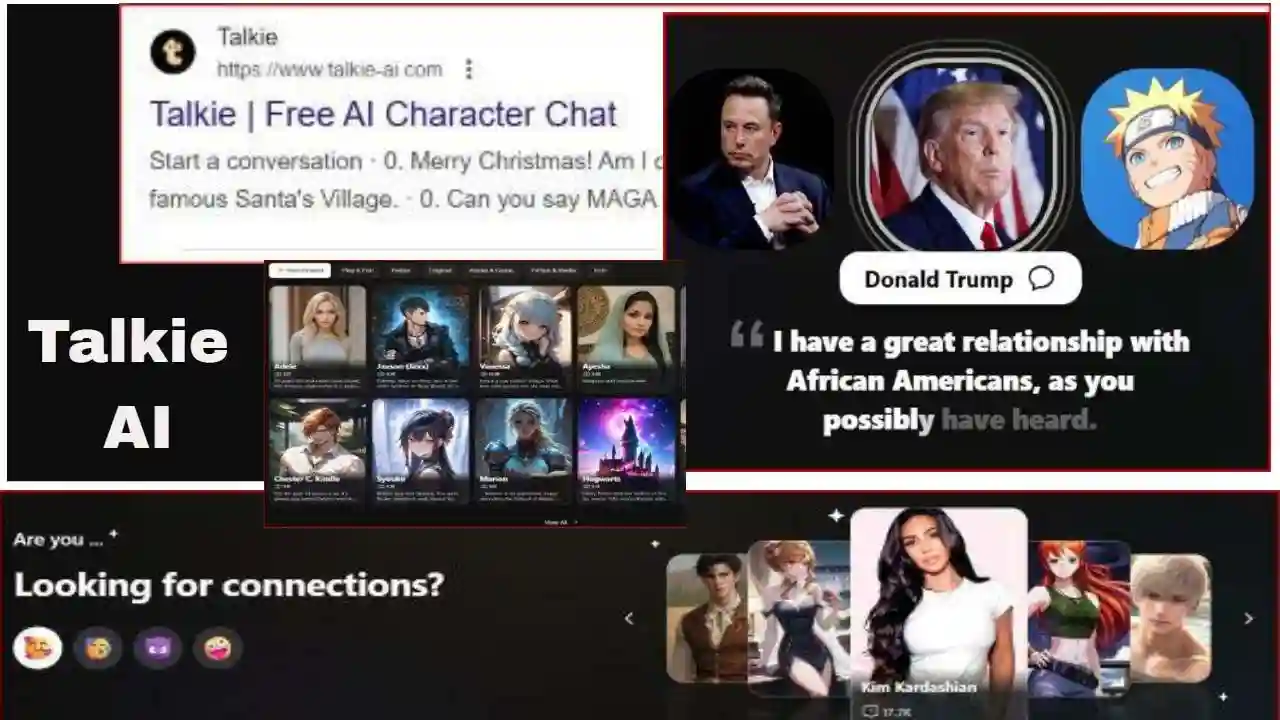Talkie AI: Features, Pricing, Real Use Cases, and Comparison
The Viral Voice Chatbot AI App Turning Text into Celebrity Calls. Talkie AI is a new voice-driven chatbot app that lets you call and chat with AI versions of celebrities and characters. Learn how this viral Talkie AI(and Talkie AI review) works, its top features, Pricing, fun but Real-World use cases, and Comparison in our detailed overview.
Talkie AI
Imagine calling a number and hearing the voice of your favourite celebrity on the other end. This is the reality of Talky AI, a personal voice chat app that turns your text messages into instant phone calls. Launched by Shanghai-based startup MiniMax, Talky lets you chat and have realistic conversations with characters created by AI, from pop stars to original characters.
It exploded into viral fame in the U.S. after TikTokers posted clips of themselves “calling Taylor Swift” and other celebrities on the app. The enthusiastic reception Talkie has received highlights the app’s purpose: to turn empty conversations into interesting stories, emotional support, and language practice.
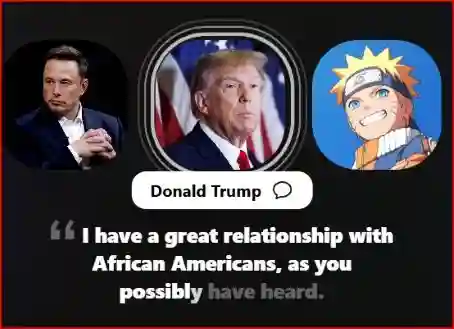
Essentially, Talky AI is designed to make conversations feel as real as a phone call. It is gaining popularity, especially among Generation Z, due to trending topics on social media and impressive reviews. With millions of users trying to connect with their favourite fictional characters or public figures, this year’s Talkie has become based on artificial intelligence.
What is Talkie AI, and how does it work?
Talkie AI is a popular voice chat app that allows you to interact with AI-powered characters as if you were talking on the phone. Use realistic speech synthesis to simulate conversations with celebrities, fictional characters, or custom creations. Users can customise sound settings, choose colours, and even collaborate in public reading rooms.

In this Talkie AI review, we discuss its rise in popularity from Shanghai to the US, its main voice calling feature, and how it compares to other AI-powered chatbots.
Talkie AI: From Shanghai Startup to U.S. Sensation
Talkie AI began life as Glow, a companion-chat app launched in China around 2022. The developer, MiniMax, founded in 2021 in Shanghai, quickly refined the app and rebranded it for overseas markets. By mid-2023, Glow was relaunched globally as Talkie (known as “Xingye” in China) with a fresh name and interface tailored for English-speaking users.

This strategic rebranding – complete with a catchy new logo – helped Talkie shed local stigma and appeal to international audiences. The timing couldn’t have been better. Shortly after launch, Talkie’s download numbers took off. Within months, it amassed over 10 million installs in the U.S., ranking among the top AI entertainment apps nationwide. Sensor Tower data showed Talkie was the 4th most-downloaded AI app in the U.S. in early 2024, even surpassing Google-backed rivals.
This growth was fueled by enthusiastic Gen Z fans: content creators on TikTok and Instagram began sharing their funniest and craziest Talkie calls (imagine hearing “Taylor Swift” drunkenly singing or “Sherlock Holmes” giving you clues by phone!). Each viral video sparked millions of views and thousands of new sign-ups.
The buzz snowballed as more influencers and meme accounts discovered the app, cementing Talkie’s status as a youth-driven viral hit. MiniMax’s gamble paid off. By late 2024, Talkie had chalked up tens of millions of global downloads (Sensor Tower estimated ~17 million in the first 8 months of 2024) and captured a devoted base of mostly young users.
Behind the scenes, the company attracted major investment (from gaming giant miHoYo and others) and even toyed with game-like features (“companion cards,” collectables, etc.). But the core draw remained: realistic AI voice calls that felt like talking to a friend.
Talkie AI Core Features That Spark Conversation
Talkie’s biggest hook is its phone-call interface. Instead of typing, you literally dial (or tap) to start a call with an AI character. The Talkie AI uses advanced text-to-speech to give each character a distinct voice, tone, and accent. You can customise the experience – adjust the voice’s pitch, the length of the call, and even background ambience (city noise, romantic music, etc.).
Want a dramatic movie scene? You can set the mood. This phone-style interaction feels surprisingly real, blurring the line between a casual phone chat and a high-tech AI experience.
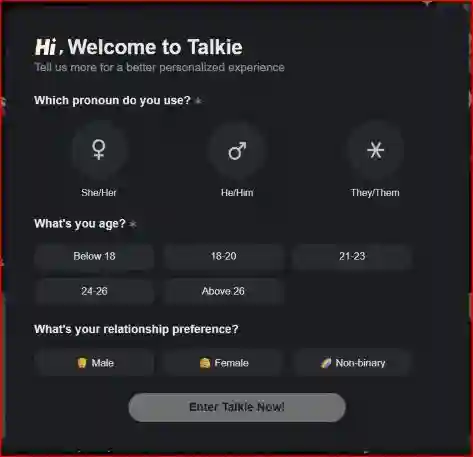
Phone-Style AI Calls: Realistic voice conversations are Talkie’s signature. The Talkie AI simulates an actual call: you hear a ringing tone, a greeting from the character, and then a chat in real-time. Talkie leverages neural TTS so the voices sound natural. Users can tweak settings (voice gender, speed, ambient sound) to tailor the vibe of each call. With presets ranging from soft-spoken to energetic, a Talkie call can be a calming, friendly chat or an adrenaline-pumping game mission briefing.
Build Your Own Talkie: The other core feature is character creation. You can pick from hundreds of pre-made “AI celebrities” – from Hollywood stars and anime characters to historical figures – or invent your own personalities. For custom characters, you define traits like name, backstory, quirks, and even an accent. The AI will then role-play them during calls.
For example, you might create a pirate persona with a Scottish brogue or a futuristic robot with a monotone voice. Talkie’s emphasis on storytelling means your custom characters can have rich personalities and narratives that evolve as you talk.
Beyond Voice (Multimodal): While Talkie is voice-first today, it’s building a multimodal experience. Currently, you can also chat via text if you prefer typing or switching modes on the fly. The Talkie AI features visual “cards” and images for each character profile. Down the road, Talkie plans to add video and more advanced AR/VR integration – imagine a character avatar popping up on screen as they talk.

Meanwhile, a lively community has grown around Talkie’s script rooms: shared spaces where users collaborate on dialogue scripts or collect voice encounters. You might find themed chat threads (like “mystery calls” or holiday storylines) where people write and share creative Talkie call scenarios.
Talkie AI Seamless Experience Across Devices
Talkie is built to run smoothly anywhere. Mobile apps are available for both Android and ios (the ios version briefly faced removal in late 2024 for technical reasons, but returned to service), and there’s even a web version.
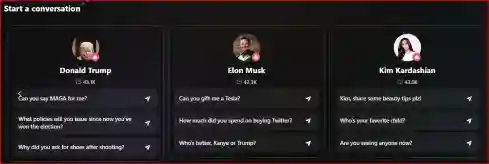
The Talkie AI is optimised for low latency, so voice replies come through with minimal lag, which is crucial for keeping the phone-call illusion intact. Whether you’re on a phone, tablet, or laptop, Talkie’s interface adapts (big buttons, easy mic/call controls) so chatting feels easy and consistent.
Inside the Talkie AI, a strong sense of community keeps users engaged. You can join in-app groups, share your favourite character creations with friends, or browse trending “Talkies” that others made. The app often features peer-to-peer challenges or prompts (for example, “Tell the scariest ghost story and hear the ghost’s reaction!”) to spark new conversations.
This social layer makes Talkie more than just solo chats; it’s a place where creators and fans trade ideas. It’s common to see discussions about the funniest dialogues or tips for customising voices, all without leaving the app.
How Talky AI Makes Money (and Why You Might Too)
Like many viral apps, Talkie follows a freemium model.
Talky AI Pricing
Downloading and using the basic call features is free, supported by ads or call-time limits. For example, free users might get a few minutes of talk time per day with mid-tier voices and hear periodic ads between calls. To unlock the full experience, Talkie offers a paid subscription (“Talkie+” or similar). Subscribers enjoy longer calls (even unlimited minutes), exclusive high-end voice models (celebrity-impression-quality voices, AI singers, etc.), and an ad-free interface.
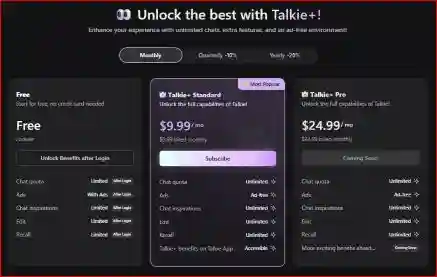
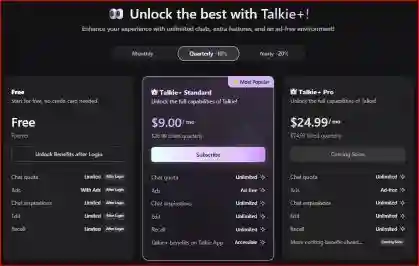
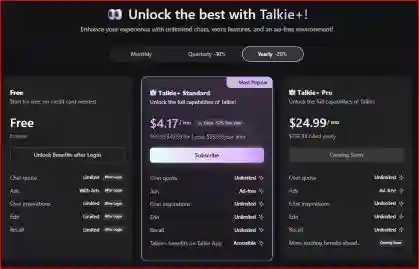
Beyond the main subscription, there are in-app purchases. You can buy specialised voice packs (e.g, “Fantasy Voices Pack” or licensed character packs), sound effect bundles (adding footsteps, laughter, etc.), or virtual currency for extra chat unlocks.
During early growth, the company also experimented with a collectible card or “gacha” system – earning character cards through gameplay, though this is secondary to core chat revenue. And interestingly, there are ways users can leverage Talkie for income or side projects. Some creative users repurpose their Talkie calls into content: for instance, compiling comic “audio dramas” on YouTube using Talkie voices, or writing AI-driven fan fiction and narrating it with Talkie characters. Popular Talkie content creators can monetise via Patreon or sponsorships.
As the platform grows, savvy fans have even speculated about affiliate or ambassador programs (referral links, voice acting gigs for Talkie films, etc.). In short, Talkie’s business model revolves around addictive chat features – but it also opens doors for enterprising users to turn their creativity into cash.
Talkie AI Real-World Use Cases
The flexibility of sound cinema has given it the potential to find unexpected applications beyond entertainment. Some known uses include:

Voice acting: Independent writers and producers use low-budget talkie films as voice actors. By calling characters, you can record entire conversations for podcasts or animated videos. This is a great option for voice actors who need a quick voice sample without hiring an actor.
Emotional Support & Companionship: Much like AI, such as Replika, Talkie can offer comfort. People who are lonely or anxious sometimes call an AI friend or “mentor” for a sympathetic conversation. The realistic voice element can make users feel more connected than plain text chat. Importantly,
Talkie allows you to choose the tone: you can “call” a gentle grandmother figure when upset, or a pep-talk coach before a big event.
Language Learning Practice: Talkie supports multiple languages and accents. Language learners can create or find characters who speak the target language fluently. By conversing in (say) Spanish or Mandarin with an AI, students practice real-time listening and speaking. Customising the call to make the AI speak slowly or use specific vocabulary turns Talkie into an interactive tutor.
Generating story ideas for writers: Writers use dialogue as a tool to express ideas. For example, a writer might ask their main character to express their reaction to a scene or discuss their thoughts on the plot. Teachers and players can also find creative uses: imagine a history teacher inviting “Abraham Lincoln” to speak about leadership, or a player acting out an epic dragon adventure.
Talkie AI Competitive Snapshot
Talkie isn’t the only player in the AI chat space, but it does stand out. Consider Character.ai: a popular platform for AI character conversations. Character.ai excels at creative, text-based storytelling and leverages powerful language models, but it is text-only (except for a recent voice-chat experiment).
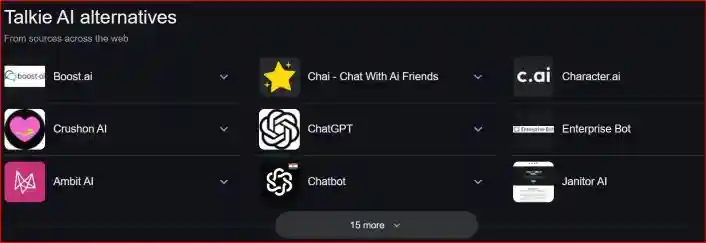
Similarly, popular AI apps like ChatGPT focus on written questions and answers on a variety of topics. Talky, on the other hand, offers the unique feature of interacting with live characters via voice in real-time, which makes communication more personal.
Another comparison is Replica, an AI assistant designed to provide emotional support. Replica offers a helpful “friend” with whom users can talk, but its style is more like a monologue, lacking the artificial personality diversity of spoken-word movies.
This voice device is telephone-sized and supports multiple voices: in a matter of minutes, you can switch between a rock star, a robot, or a medieval knight. Future features (video chat with avatars, AI-generated songs) will further improve the speaker.
In short, Talkie AI facilitates immersive voice conversations with characters, while other AI-based chat apps work with text messages or generic chat characters. This increases competition, especially for users who find voice input more appealing than plain text.
Talkie AI Privacy & Safety
Talkie AI takes several steps to keep chats safe, but as with any AI app, users should stay mindful. According to its policies, Talkie collects and stores conversation data to improve its AI voice models and personalise chats, but it promises not to use your chat content for advertising.

Only you and the AI hear your talkie conversation; it’s not broadcast or shared outside the app. However, all chats are presumably logged by Talkie’s servers (so sensitive info should be avoided). The developers do not keep your recordings longer than needed, and they anonymise data used to train the AI. Please note that for younger users, Talky’s terms and conditions stipulate a minimum age (14+ or 13+ in some regions).
Talkie AI has no strict parental controls, so parents should use the app to keep an eye on their children. The company’s rules clearly prohibit inappropriate content: no sexual or violent interactions involving minors, hate speech, incitement to suicide, or illegal instructions. The AI is trained to refuse or flag forbidden topics.
In practice, this means that most chat is still suitable for adults aged 13 and over. However, the AI can sometimes malfunction, so caution is needed. Chat prefers respectful fictional characters over real personal advice. Talkie also warns users not to share personal information (phone numbers, email addresses, financial information) in chat; the AI characters do not need these details.
In general, Talkie’s privacy policy is consistent with many technology applications: data is used to improve the service, and illegal or explicit use is prohibited. The voice component offers additional customisation compared to text bots, but does not pose any additional risks when used responsibly.
As always, users (and parents) should keep in mind the age guidance and the fact that the chatbot is powered by AI – it’s clever, but not a real human.
The U.S. Footprint on Talkie AI
Talkie’s biggest market by far has been the United States. In just its first year of availability, the U.S. saw millions of downloads and active users. Sensor Tower data showed Talkie hitting the top charts for AI apps nationwide.

Demographically, the Talkie AI is primarily targeted at young people: about 70% of users are under the age of 35, and 50% of users are college students and young professionals. Many users live in major technology and entertainment hubs (California, New York, and Texas), where social media trends spread rapidly.
Usage figures are impressive: by mid-2024, Talkie AI had recorded more than 11 million monthly active users, more than half of whom were Americans. The average conversation duration of a call is several minutes, and customers typically make several calls per day (a leading interlocutor to dozens of chat transcripts per day). (Provided) Although the Talkie AI app is free to download, it generates revenue through subscriptions and in-app sales. Minimax is reportedly on track to reach annual revenues of around $70 million (mostly from talking pictures) by the end of 2024, reflecting the app’s high engagement, payment, and conversion rates.
Geographically, English-speaking countries drive the bulk of usage: the U.S., followed by Canada, the UK, Australia, and some Southeast Asian markets where the app has caught on. (In China, the domestic counterpart “Xingye” exists but focuses more on text chat.) Within the U.S., usage is nationwide, though social media monitoring shows spikes of activity around college towns and urban centres where TikTok trends often begin.
What’s Next for Talkie AI
Talkie is evolving fast. The company roadmap hints at exciting new features: video chat avatars (imagine seeing a character’s face lip-sync as you talk), AI-generated music/singing (characters humming tunes or rapping your messages), and even real-time voice cloning (soon you might recreate any celebrity’s actual voice, subject to legal rules).
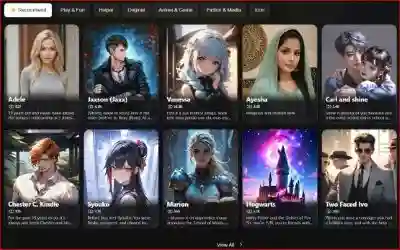
The AI’s speech synthesis is already impressive, and updates are expected to make voices more nuanced (emotions, intonation, and multiple languages will only get better). Beyond core tech, potential partnerships loom on the horizon. Telehealth and mental wellness apps might license Talkie’s voice tech to provide conversational companions for patients. Events and marketing teams are eyeing Talkie for brand activations (imagine meeting an “AI [Sports Team Mascot]” at a game through your phone).
Educational programs could integrate Talkie characters as tutors or interactive storytellers in classrooms. MiniMax has hinted at working with media franchises to bring official characters (novel heroes, comic figures) into Talkie’s roster. As AI and voice tech become mainstream, Talkie is positioning itself as a bridge: a fun app today that could power tomorrow’s conversational interfaces in health, entertainment, and customer service.
Talkie AI Conclusion
Talkie AI stands out in the crowded chatbot world by making conversations feel like real phone calls with your favourite characters. Its blend of advanced AI speech and community-driven storytelling is what makes it unique. We encourage you to download Talkie (available on app stores) and try dialling a character yourself – maybe start with your favourite pop star or an original hero you create.
Share your funny or inspiring stories using the voice device on social media or in the comments.
Don’t miss additional content: We’re preparing in-depth guides (like how to create your own AI-powered celebrity chat on Talkie AI) and interviews with Talkie’s top content creators. We may also host writing workshops where you can create your own stories using AI. In the meantime, welcome to the future of chat: a future full of voices, people, and fun!
Talkie AI – FAQs
How real do Talkie AI calls feel?
The level of realism in Talkie AI is amazing. The Talkie AI uses advanced neural speech models to make the characters speak with natural voices and emotions.
You hear dial tones, background noises, and a soft voice on the other end of the line: it’s like a telephone conversation. However, because it’s based on artificial intelligence, the voice can sound a bit robotic, and if you ask a difficult question, the character may give unexpected answers. Overall, most users found the sound to be impressive and realistic enough to enjoy.
Can I upload my own voice or character?
Currently, you can’t directly upload audio of your own voice to Talkie. Instead, you create characters using the app’s interface. You choose a name, personality traits, and select from a range of preset voices and accents. You then teach the AI your character’s background through text prompts, and the app animates the voice and persona.
In the future, Talkie plans to add voice-cloning features, which may let you train the AI on your own voice or someone else’s (within legal limits). But for now, custom voices are built from the app’s library, not user-uploaded recordings.
Is Talkie AI safe?
The Talkie AI is designed for users aged 14 and up (13 and up in some regions). The company has rules against posting any explicit or harmful content, so conversations are generally appropriate.
However, it doesn’t have any strict parental control settings. Teens often use the audio device to role-play and write stories, which is fine, but parents should keep an eye on teens as with any social app, and remember that the voiced characters are created by artificial intelligence, so sometimes they say unexpected things. It’s best to keep conversations informal and let us know anything that makes you uncomfortable or confused through the feedback tools in the app.
Overall, Talkie AI can be a creative and safe platform for older teens, but younger users should be cautious and possibly check it out with their parents.
What’s included in Talkie AI free vs. paid?
The free version of Talkie AI lets you make a limited number of calls per day using the standard voice. During the call, you will see ads and some limitations (such as a maximum call duration).
Paying users enjoy premium features: unlimited talk time, longer calls, high-quality unique voices (such as celebrity or cartoon voices), no ads, and subscribers get early access to new features (such as trial sound packs) and additional bonuses such as extra coins for in-app purchases.
In short, free users get basic calling features, while paying users enjoy the full, unlimited Talkie experience.
How does it compare to other AI chat apps?
Unlike text-only chatbots, Talkie’s main focus is voice interaction. For example, Character.ai and many ChatGPT-based apps only offer typed conversations (they may have some voice plugin, but it’s not a core feature). Talkie’s competitive edge is that it feels like a phone call.
Compared to Replika (an emotional-support AI), Talkie has a greater variety of characters and a more playful tone. Compared to Siri or Alexa, Talkie isn’t just a utilitarian assistant – it’s a full-fledged character with personality. Each AI chat app has its niche: Talkie’s niche is live, phone-like roleplay with characters, which makes it unique among AI chat platforms.
